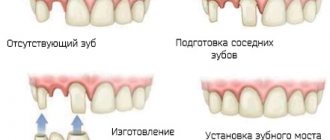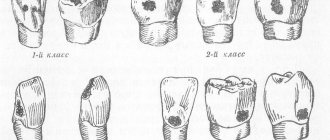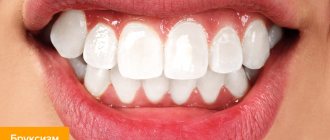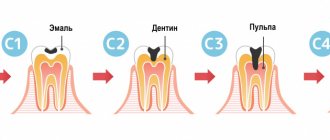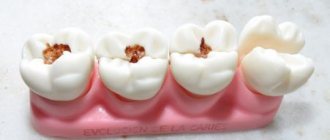Today we will talk about the Black classification of caries, known in dentistry.
This scientist devoted a lot of time to researching this disease and, as a result, systematized the knowledge gained and invented his own gradation of this disease, which became popular among medical practitioners.
The most fundamental is the classification of carious cavities, which was invented by Black in 1896. He identified 6 classes of dental damage from this disease. The purpose of introducing this classification was to standardize the methods of preparation and filling of carious cavities. The filling technique directly depended on the type of caries localization.
The discovery of this system was more than a hundred years ago, therefore it is considered not a complete classifier, since carious lesions of the root system and secondary nature are not taken into account.
Despite this, Black's classification of caries is still widely used by dentists. Over time, the system for ranking damage to this disease was modernized, and an additional 6th class was added to its 5 elements. Let's take a closer look at each class separately!
Classification of caries lesions according to the process
In this direction, there are 3 types of dynamics of the course of this disease: fast, slow and stabilized.
Also, this pathogenic process can be considered by the extent of its localization: caries manifests itself on one tooth, on several elements, or is systemic in nature and affects most of the different teeth in the upper and lower rows.
How do I know if I need a filling?
Although obvious damage or decay may signal the need for tooth decay treatment and a filling, many teeth in cavities go unnoticed. This is why it is important to attend regular dental checkups to catch minor problems before they get worse. If the damage or destruction progresses, you may need root canal treatment. During the examination, the dentist will identify problematic issues by carefully examining each tooth, using x-rays, a dental microscope and other tools for diagnosing the oral cavity. If a problem is discovered with a tooth, the dentist will be sure to treat and fill it, preserving the appearance and function of your tooth.
Classification of caries according to the sequence of occurrence
As in the previous gradation, experts distinguish 3 types of carious lesions.
The first category includes caries that appeared on a tooth for the first time.
The second is a re-injury to a previously filled tooth. In the vast majority of cases, this disease spreads around or under the filling.
The third category includes the so-called recurrent caries lesion. It occurs due to insufficient treatment of the area or a poorly installed filling.
Secondary caries is all new carious lesions that develop near a filling in a previously treated tooth. Secondary caries has all the histological characteristics of a carious lesion.
The reason for its occurrence is a violation of the marginal seal between the filling and the hard tissues of the tooth; microorganisms from the oral cavity penetrate into the resulting gap and optimal conditions are created for the formation of a carious defect along the edge of the filling in the enamel or dentin.
Recurrent caries is the resumption or progression of the pathological process if the carious lesion was not completely removed during previous treatment. Recurrence of caries is often detected under the filling during an X-ray examination or along the edge of the filling.
There are a large number of caries classification systems, almost all of them are repeated. Therefore, for an accurate diagnosis, it is very important for a specialist to correctly determine the depth of the cavity, the nature of the course and the main reason why the carious pathology formed.
The effectiveness of treatment and the absence of relapse processes in the future will depend on the reliability of the diagnosis.
System principle
The differentiation method, proposed by a dentist back in the century before last, is based on the use of criteria for assessing the coverage and localization of the lesion. Based on them, a systematic approach is used that allows dividing the types of caries into five classes. It is worth noting that due to the age of development, the classification does not include types of caries discovered in a later period (for example, secondary and root forms). Nevertheless, the technique remains relevant in modern practice.
Topographic classification of caries distribution
In many countries, this classification is most widely used.
It takes into account the depth of the lesion, which is very convenient for the practice of the dentist. There are 4 stages of development of this disease:
- The appearance of a carious spot. The source of demineralization of the dental element. The process of this harmful phenomenon can last either slowly or quickly, depending on the individual characteristics of the patient’s body.
- Superficial caries is characterized by local damage to the enamel on the tooth.
- Moderate caries manifests itself in damage to the surface layer of dentin.
- Deep caries clings to the peripulpal dentin and affects the tooth right down to the nerve endings.
Types of Dental Fillings
Modern dentists can use a variety of materials to make fillings, including:
- Gold fillings: Made in a laboratory and then cemented in place, gold fillings can last more than two decades and are well tolerated by the gum tissue. However, they are a relatively expensive option and require multiple visits to the dentist.
- Amalgam fillings: These are relatively inexpensive and hold up well. Unfortunately, their dark color can make them more noticeable than composite or porcelain restorations. This makes them a good choice for filling premolars or molars that are located in the back of the mouth.
- Composite resins: Designed to closely match the natural appearance of teeth, composite fillings are made of various ingredients that are mixed and placed directly into the cleaned cavity. Once they harden, composite fillings are very strong. However, they are vulnerable to staining and may chip or wear off over time. This is one of the reasons why dentists often recommend porcelain fillings for cavities that are more than 40% decayed.
- Porcelain fillings: Also called porcelain onlays, these fillings are made in a laboratory and then bonded to the tooth. They are highly stain resistant and can be precisely matched to a person's individual tooth color. In many cases, a porcelain restoration will cover most of the tooth, and the total cost will be slightly higher than a composite restoration. In cases of destruction of the crown part of the tooth by more than 40%, the tooth must be covered with a crown. metal-free crowns, ceramic and composite onlays. metal-ceramic crown plastic and composite dental crowns zirconium crown
Differences between chronic caries and acute
Let's take a closer look at the features of the chronic and acute forms of this disease.
The acute form of caries is characterized by the rapid development of destructive changes in the hard tissues of the tooth, the rapid transition of uncomplicated caries to deep caries.
The affected tissues are soft, slightly pigmented (light yellow, grayish-white), moist, and can be easily removed with an excavator.
Chronic caries is characterized as a slow process (several years).
The spread of the carious process (cavity) is mainly in the planar direction. The altered tissues are hard, pigmented, brown or dark brown in color.
What is tooth filling in dentistry?
Fillings involve the use of artificial materials to seal a crack or hole in a tooth. When dentists place fillings, they begin by removing the decay. The cleaned cavity is then filled with a tooth-colored composite material, porcelain, gold, or an amalgam alloy of silver, mercury, tin, copper, and sometimes zinc. As we all know, fillings help prevent further tooth decay by protecting against infection of the dental pulp. They also restore chewing function so patients can chew with their teeth with confidence.
Type of caries according to degree of activity
There are 3 types of caries in this category: compensation, subcompensation and decompensation.
Compensatory caries is characterized by a slow or non-progressive process.
Damage to the surface of the teeth is insignificant and does not cause any discomfort in the patient.
With regular and systematic hygiene procedures, as well as special preventive measures, it is possible to stop the development of the disease at its initial stages.
Subcompensatory caries is characterized by an average rate of progression, at which it can go unnoticed and not cause concern to the patient at all.
Decompensation caries is expressed by intensive development and dynamics of progression, accompanied by such acute pain that it affects both the patient’s ability to work and everyday life.
Because of this, the disease is often called acute caries. It requires immediate treatment procedures, since otherwise the process may spread to third-party teeth with the subsequent addition of pulpitis and periodontitis.
Types of caries
Another classification of carious cavities according to Black looks like this and is based on what parts of the teeth they affect:
- Fissure. Most often, this variety occurs in children, and its insidiousness lies in the difficulty of identifying the disease in the first stages of its development. This is due to the fact that the destruction is almost invisible in the chewing areas, and when it appears on them, the disease takes on a fairly advanced form;
- Interdental. Such damage is also not always immediately determined, but reveals itself when the diseased tooth begins to cause noticeable discomfort due to serious damage;
- Cervical. They are easily diagnosed, since even with a routine in-person examination, the doctor can see the characteristic dull white spots that appear in the early stages of caries formation;
- Atypical. With this type, the mounds of the chewing teeth or the cutting parts of the anterior units are the first to be affected. This variety is the rarest, but diagnosing it is not difficult even in the first stages of the formation of the disease.
Black distributed carious lesions into types and in accordance with their depth:
- Elementary. Signs of the disease include white or dark spots on the teeth, but it is not accompanied by damage to the enamel;
- Surface. It is characterized by damage to the upper enamel layer, its roughness, sensitivity of the tooth, which begins to react to cold, hot, spicy, sour, sweet foods;
- Average. With this type, the enamel is affected, affecting the dentin. It may be accompanied by pain, so in this case it is no longer possible to delay treatment;
- Deep. This type of caries is accompanied by destruction of tooth tissue and dentin. Ignoring the disease in this case is fraught with affecting the pulp, which can result in periodontitis and pulpitis.
This is one of the Black classifications most commonly used by dentists.
Clinical principles for preparing carious areas
To carry out all the necessary therapeutic manipulations, many specialists rely in their work on Black’s classification of caries.
For any of the above types of tooth damage from caries, it is necessary to carry out full preparation and filling.
The durability of your tooth (or several) depends on the quality of these manipulations.
Experienced dentists, when removing soft carious dentin, can leave its deep pigmented elements to avoid damage to the tooth pulp. After carrying out this work, there should be no affected tissue left on the walls of the cavity.
At all stages of preparation and filling, the dentist sets the main goal - to destroy the carious areas of the affected tooth, disinfect the remaining parts and apply a hermetically sealed structural material that can restore the structure of the tooth and help it fully perform its functions in the future.
Preparation algorithm
According to the system developed by this scientist, the process is carried out in 5 stages:
- First, the dental cavity is opened and the enamel is removed in order to remove the damaged part of the dentin;
- Next, it expands to remove those tissues that are at risk of further rotting and destruction;
- A process of necrectomy is also carried out, which involves the removal of dentin, which has pigments and a soft structure;
- The next stage is the formation of a cavity into which a filling is placed that can withstand the required level of load placed on the tooth;
- The final step is finishing, which involves processing the edges of the cavity to eliminate damage and roughness of the enamel.
Black fillings are installed in this order and using these classifications, and despite the fact that his invention is more than a century old, it remains relevant to modern dentists to this day.
Did you like the article?
Rate: ( 5.00 out of 5)
Loading…
Treatment of caries of the chewing teeth
| Tooth restoration with inlays, veneers, half-crowns made of photopolymer material using the direct method | 10,000 rub. |
| Applying a temporary filling | 500 rub. |
| Restoring a tooth with a filling I, II, III, V, VI class according to Black using chemical curing materials (preparation for a crown) | 3850 rub. |
| Tooth restoration with a filling I, V, Black class using materials from photopolymers | 4900 rub. |
| Tooth restoration with a Black class II filling using chemically cured materials using a fiberglass pin | 5500 rub. |
| Tooth restoration with a filling, class II according to Black, using materials from photopolymers (1 contact surface) | 6000 rub. |
| Tooth restoration with a filling, class II according to Black, using materials from photopolymers (2 contact surfaces) | 6500 rub. |
| Sealing the tooth fissure with sealant | 3300 rub. |
Treatment of caries of the anterior group of teeth
| Tooth restoration with inlays, veneers, half-crowns made of photopolymer material using the direct method | 10,000 rub. |
| Applying a temporary filling | 800 rub. |
| Restoring a tooth with a filling I, II, III, V, VI class according to Black using chemical curing materials (preparation for a crown) | 3500 rub. |
| Tooth restoration with filling I, II, III, V, VI class according to Black using materials from photopolymers | 3850 rub. |
| Tooth restoration with a filling I, V, Black class using materials from photopolymers | 4700 rub. |
| Tooth restoration with a Black class II filling using chemically cured materials using a fiberglass pin | 4900 rub. |
| Tooth restoration with a filling, class II according to Black, using materials from photopolymers (1 contact surface) | 6100 rub. |
| Tooth restoration with a filling, class II according to Black, using materials from photopolymers (2 contact surfaces) | 6900 rub. |
| Restoring a tooth with a filling, class IV according to Black, using materials from photopolymers | 8900 rub. |
Aesthetic dental restoration
| Aesthetic tooth restoration with filling I, V, Black class using materials from photopolymers (Fissure area) | 6800 rub. |
| Aesthetic tooth restoration with a filling, class II according to Black, using materials from photopolymers (1 contact surface, chewing group of teeth) | 8200 rub. |
| Aesthetic restoration of a tooth with a filling, class II according to Black, using materials from photopolymers (2 contact surfaces, chewing group of teeth) | 10500 rub. |
A few words about the international classification of the ICD
In medical practice, attempts have been made more than once to create something like a unified system that would be universal and in which there would be a place for descriptions of each disease. As a result, in 1948, doctors created the International Classification - ICD. The system was often revised, supplemented and expanded. The last 10th revision was carried out in 1989, so today we have the ICD-10 classification at our disposal.
Since 1994, this system has come into wide use and has become the main one for medicine in countries belonging to the World Health Organization. For caries there is a separate large category under item K02. This includes all types of caries, including enamel, dentin and cement, as well as suspended caries, pulp exposure, odontoclasia and other forms of the disease.
Principles of dental treatment taking into account the Black classification
As mentioned above, Dr. Black proposed his classification in order to optimize approaches to the treatment of caries at different stages and with different localizations. Therefore, each class he identifies involves its own methods of preparation and filling - let’s look at them in more detail.
Fissure caries
Preparation of affected tissues involves reducing the bevel of the enamel and applying a dense layer of composite, since we are talking about the chewing surface, which bears the main mechanical load. Typically, a cone-shaped bur with a rounded edge is used for this purpose, which allows the formation of a cavity, the shape of which corresponds to the shape of natural fissures. A chemically cured composite or a light-curing material (applied in oblique layers) can be selected as a filling material.
When treating fissure caries, a cone-shaped bur is used
Contact surfaces of molars and premolars
In this case, preparation is usually carried out through the chewing surface. First, the cavity is opened, if necessary, it is expanded, the affected tissue is removed, the walls of the cavity are formed, and then the enamel bevel is processed. In this case, special attention should be paid to ensuring the tightest possible contact between the composite and dental tissues. For this, a thin matrix can be used, and the tooth itself is slightly shifted using special wedges. To improve the fixation strength of the composite material, the edges of the cavity are pre-treated with a special adhesive.
This type of treatment is quite painstaking.
Incisors and canines (without cutting edge)
Here the doctor faces a difficult task - to recreate the natural shape and appearance of the damaged element. Therefore, aesthetic composite materials are chosen to fill teeth that fall within the smile zone. Preparation is carried out using lingual access. Along with the affected tissues, pigmented areas of dentin are also removed. To achieve a natural transition of shades, overlap the enamel bevel by 2-3 mm.
Cutting edges
Incisors and canines destroyed by less than 1/3 are restored using composite restoration with preliminary removal of necrotic tissue. If half of the crown is damaged, veneering with a composite material can be performed, that is, installation of a veneer using the indirect method. If more than half of the tooth is affected, an artificial crown is usually fixed.
Veneers can be used to treat this type of caries.
Vestibular surfaces
To cover such defects, a composite is used, but in the case of extensive damage to a large area, a composite-inomer composition can be chosen. When the front teeth are destroyed, aesthetic light-curing materials are used to restore them.
Incisal edges of incisors and molar cusps
If there is no need to change the bite height, standard cavity preparation and composite application are performed. If it is necessary to increase the height of the bite, most often a specialist will install an artificial crown. In some cases, veneers are installed to cover defects.
Often, during treatment, a specialist places an artificial crown
Dr. Greene Vardiman Black
Dr. Greene Vardimar Black is a well-known personality who is at the forefront of the development of dental science in the United States of America. He was born in 1836 in the city of Winchester.
At the age of 17, the young man became interested in medicine and worked for several years as an assistant to dentist D.S. Spira, while simultaneously gaining theoretical knowledge on this topic.
After completing his education, Greene Vardimar Black opened his own dental office in Jacksonville. In addition to providing services to the public, Dr. Black never stopped studying science and improving himself.
In 1870, a specialist invented a mechanical drill equipped with a foot drive. The gold amalgam composition developed by Dr. Black is also used in modern dentistry.
In addition, the specialist brought the terminological base to the standard, and also developed a classification of carious cavities and cutting dental instruments.
Dr. Black compiled several books that described methods for preparing the tooth surface, touched on the features of therapeutic dentistry, and also described some pathologies. In addition, Mr. Black taught dental science at the College of Chicago and also served as dean of the Northwestern University School of Dentistry.
